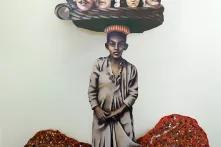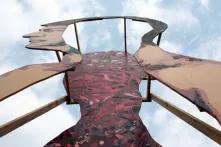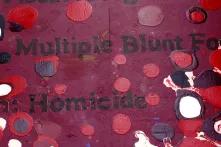
Dummy Boards
In ihrer Form bezieht sich die Arbeit von Rajkamal Kahlon auf die europäische Tradition der „Dummy Boards“, auch bekannt unter dem Namen „Silent Companions“ (Stille Begleiter). Sie bezieht sich auf die niederländische Trompe-l’œil-Malerei, die mit der Präsentation eines illusionistischen Raumes die BetrachterInnen zu täuschen versucht. Dies erreichte sie oft mit Hilfe von Holzplatten in der Form des gemalten Objektes. Solche Dummy Boards stellen häufig Hausdiener dar und wurden in Räumen, wie Salons oder vor Kaminen ausgestellt. Teil ihrer Aufgabe war es, BetrachterInnen glauben zu lassen, jemand stünde im Schatten des Raumes.
Wie auch in meinen vorangegangenen Projekten bin ich hier daran interessiert, die ideologischen Positionen bei der Produktion und Verbreitung von Bildern zu untersuchen, die im Zusammenhang mit historischen und zeitgenössischen autoritären Regimen stehen. Dummy Boards, die inzwischen zu einer volkstümlichen Form der Malerei geworden sind, werden von mir in ihrer Größe und ihrem Zweck verändert. Damit wird die Rolle der Bediensteten oder des kolonialen Subjektes im Verhältnis zu Macht und Geschichte umgedeutet. Meine Dummy Boards oder 3-dimensionalen Malereien haben Vorder- und Rückseite sowie zwei Seiten, wodurch sie die Grenzen und Beziehungen zwischen Malerei und Skulptur erweitern, während sie sich dem Genre der ethnografischen/kolonialen Fotografie und anderer zeitgenössischen Bilder als Quellen bedienen. Die Arbeiten erzeugen verschiedene Gegenwarten und negieren Illusionen, sobald die BerachterInnen sich zum Zentrum hin- oder von diesem fortbewegen.
In form the work relates to the tradition within European painting, of "Dummy Boards," also known as "Silent Companions." It began with the Dutch Trompe l'oiel tradition of tricking the viewer with the presentation of illusionistic space. This was sometimes achieved on panels created in the shape of the figure or object being painted. Dummy boards were often of servants and were placed in domestic settings such as drawing rooms or in front of fireplaces. Part of their function was to trick the visitor into thinking someone was standing in the shadows of a room.
As with my past projects, I am interested in examining the ideological positions within the production and distribution of images as they connect to historical and contemporary regimes of power. Taking dummy boards, which have mutated into a vernacular painting form, I am changing them again, in scale and purpose. They recast the role played by the "servant," or colonial subject in relation to power and history. My dummy boards, or 3-dimensional paintings have fronts, sides and backs and extend the boundaries and relationship between painting and sculpture and use the genre of ethnographic/ colonial photography and contemporary media images as source material. The work's form simultaneously presents and negates illusion as the viewer moves toward and away from it's center.
Die Bilder aus dem Socrates Sculpture Park entsprechen dieser Idee jedoch in monumentaler Größe (8 Meter). „Autopsy“ (Arbeitstitel) ist ein Berührungspunkt zwischen Malerei und Bildhauerei, der textbasierte Beschreibungen des Körpers nutzt, die aus Autopsieberichten U.S.-amerikanischer Militärgefängnisse im Irak und in Afghanistan stammen. Ein phantasierter nicht-europäischer Körper wird im universellen Raum situiert, und dient als symbolischer und literarischer Rahmen für die Eigenart des anonymen Körpers, der hier in einer kühlen, rationellen und wissenschaftlichen Sprache beschrieben wird.
The last images from Socrates Sculpture Park are this idea but put into a monumental scale. It measures over 24 feet high (8 meters). Autopsy (working title) is a meeting point between painting and sculpture and employs textual descriptions of the body extracted from U.S. military prison autopsy reports released from Iraq and Afghanistan. An imagined non-European body is situated within the space of the universal serving as the symbolic and literal frame for the specificity of the anonymous individual bodies documented within a cool, rational and scientific language.
Über Rajkamal Kahlon
Rajkamal Kalohn hinterfragt die ideologischen Positionen von Repräsentation, die mit Formen rassistischer und kolonialer Autorität gapaart sind. In dialektischer Auseinandersetzung mit historischen Texten kritisiert sie den Willen, Menschen zu konstruieren (zu machen) etwa in den visuellen Praktiken von repressiven Regimen und deren Gebrauch gewaltsamer, psychedelisch inszenierter Bilder. Im Mittelpunkt ihrer Arbeit steht der menschliche Körper, der angesichts seiner traumatischen Begegnung mit kolonialer Gewalt, militärischer Herrschaft und Folter ins Groteske verdreht wird Kalohn war Teilnehmerin des Whitney Independent Study Program der Skowhegan School of Painting and Sculpture. Sie erwarb den Master of Fine Arts an der California College of the Arts und den B.A. an der University of California, Davis. 2006 erhielt sie den Joan Mitchell Painting and Sculpture Award und 2007-2010 die Lambent Fellowship. Ihre Arbeiten wurden in New York im Queens Museum, im Bronx Museum sowie im Oakland Museum, der White Box, Apex Art, PPOW, Ratio3 und im Arttransponder in Berlin ausgestellt. Rajkamal Kalohn lebt zur Zeit in New York, San Fransisco und Berlin.
About Rajkamal Kahlon
Rajkamal Kahlon interrogates the ideological positions of representation as they are linked to forms of racial and colonial authority. In her dialectical engagement with historical texts she critiques the will to "make" humans implicit in the visual practices backed by repressive regimes of power in part through the use of violent imagery framed by psychedelia and the human body turned grotesque through its traumatic encounters with colonialism, military rule and torture. Kahlon is a past participant of the Whitney Independent Study Program, Skowhegan School of Painting and Sculpture. She received her Master of Fine Arts from the California College of the Arts and her B.A. from the University of California, Davis. Kahlon was a 2006 recipient of the Joan Mitchell Painting and Sculpture Award and a 2007- 2010 recipient of the Lambent Fellowship. In New York, Kahlon's work has been exhibited at the Queens Museum, the Bronx Museum, Oakland Museum, White Box, Apex Art and PPOW, Ratio3 and Arttransponder in Berlin. Currently, Rajkamal Kalohn is living in New York, San Fransisco and Berlin.
Rajkamal Kahlon




